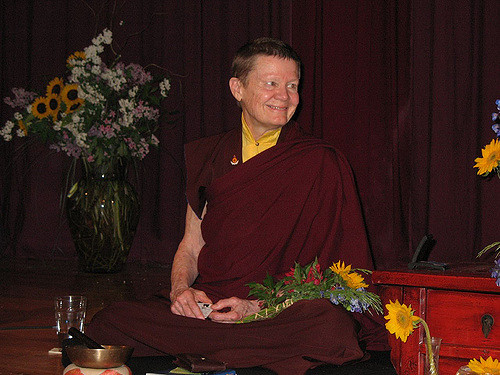
“We are warriors-in-training being taught how to sit with edginess and discomfort.” ~Pema Chödrön
Pema Chödrön’s, The Places That Scare You: A Guide to Fearlessness in Difficult Times was the book that changed my life.
A few years ago the book found me, as books do when we are ready to receive the information being shared in them. It was an old, battered copy so naturally it caught my attention, as I have a love affair with old books. Any books really, but especially those tattered copies which have been read over and over again by others. The ones which ooze wisdom and knowledge.
This one had all kinds of notes and highlighting in it, and I immediately had to know what was in this hardbound treasure chest of pages.
I opened it up randomly and found a page. The first paragraph my eyes fell upon read:
“This is a good time to remember that when we harden our heart against anyone, we hurt ourselves. The fear habit, the anger habit, the self-pity habit—all are strengthened and empowered when we continue to buy into them. The most compassionate thing we can do is to interrupt these habits. Instead of always pulling back and putting up walls, we can do something unpredictable and make a compassionate aspiration. We can visualize this difficult person’s face and say his name if it helps us. Then we say the words: ‘May this person who irritates me be free of suffering and the roots of suffering.’ By doing this, we start to dissolve our fear.”
This paragraph spoke so loudly to me because I had been living as a prisoner of my anger habit, my fear habit and my self-pity habit. These habits had been my jailer for most of my life. And I was sick of it. I was tired of myself and my anger, stubbornness and refusal to connect with people.
I thought my hard habits were what made me tough, what made me a warrior. May this person who irritates me be free from suffering? Whoa. My mind never would have come to that thought on its own.
I was blown away. Instead of putting up walls? I was like, “You mean there’s another way?” I felt as though I had a whole new understanding of life at that moment. Up until that moment, I had had no idea I could interrupt my habits. I thought they were me, an inherent part of my make-up which couldn’t be changed. I felt so empowered starting then, as though I was tapping into an infinite source of strength.
It felt as though my jailer had opened the doors of my prison and I was standing at the threshold, the doorway between the sunlight and the darkness. As I stood there I was almost in disbelief, much like an inmate who consigned him or herself to life behind bars, yet all of a sudden is offered freedom.
I was hooked. I kept reading. I came upon this:
“We can let the circumstances of our lives harden us so that we become increasingly resentful and afraid, or we can let them soften us and make us kinder and more open to what scares us. We always have this choice.”
There was that choice again! I have a choice. I pondered this for some time after reading it. I felt like I’d struck gold with this information. I have a choice! I wanted to shout to from the rooftops and tell everyone. I felt like Dr. King in his speech, “I have a dream…” I wanted the world to know and share in this knowledge that they too could have a choice in life.
I was blown away by the idea that everything I didn’t like about myself and everything I’d been labelling myself as was not inherent and could be changed. Maybe it sounds stupid, but before reading this book I didn’t know this. Pema talks about how the true warrior is one who can make an honest self-appraisal to be free from self-deception—one who can approach their own intricate network of fear and defenses they’ve built up, and get to know them so they can then claim the behavior they’ve been avoiding. In facing an identity we don’t want, say, laziness for example, we open a massive blockage put in place by our usual nature of running away and avoidance. When the blockage is cleared, the energy flows and we begin to find our inner soft spot, our bodhichitta.
“This process of experiencing laziness directly and nonverbally is transformative. It unlocks a tremendous energy that is usually blocked by our habit of running away. This is because when we stop resisting laziness, our identity as the one who is lazy begins to fall apart completely. Without the blinders of ego, we connect with a fresh outlook, a greater vision. This is how laziness—or any other demon—introduces us to the compassionate life.”
It was a brand new concept to me. This idea of facing identities head on in order to disempower them. It was the turning point in my life; it was the moment I took charge of my life and my behaviors, and started taking responsibility for how I was responding to life. It blew apart everything I had been believing about myself and my human existence.
Sure enough, once I stopped turning my face away in avoidance, I stared my anger in the face. I said, “Yes, I am angry.” It was an instant diffusion of energetic and emotional blockage which had been burying me for years. (This isn’t to say I never have to breathe through anger now, or that I never get upset. I do). The point is, it’s no longer my identity. It comes and it goes. I do not cling. I do not hide. I am no longer defined by emotions and behaviors. There’s this ebb and flow and I accept it. I am no longer stagnant.
I wandered deep into the places that scared me the most—the inner depths of my soul and mind. I swam deep in the depth of my emotional body and got to know myself. And what I came to see was this:
There was nothing there to fear. Everything I faced, I had already survived. Sure there was some weaknesses and some painful parts, but there was nothing like what I had been creating in my mind. It’s like when you finally go into the abandoned house in the woods, the one all the kids in town told scary stories about. “It’s haunted.” “Someone got murdered there.” The stores flow and keep us out because we are scared. Finally, in a show of bravado to impress our friends, we go in. Once inside, we see, there’s no ghosts, or bloodstains, or axe murderers. There’s just a house; an old, rundown, neglected and abandoned house, filled with dust, cobwebs, clutter and cracks.
Nothing scary about it. If anything, it’s lonely. And something in this realization touches us deep within, deep beyond the walls. This connection with this lonely and soft energy of the sad, abandoned house awakens our inner soft spot, our bodhichitta. During this exact moment of connection with bodhichitta is when we are our most fierce. In vulnerability we find our strength.
Being able to look upon another’s energy and see beyond the outward shell (like with the house) to connect on a deep level without saying a word, without needing to fix anything, do anything or change anything—this is the way of the warrior. To be brave enough in the moment to be present with whatever is occurring exactly as it is.
If we identify and label ourselves we keep ourselves small. If we do this to ourselves, we do it to others. Identities and labels only serve to divide.
To be present with pain, anger, sadness, joy or love without attaching filters and stories to it. Being uncomfortable and not needing to change it. Facing our own darkness and embracing it with love, compassion and good humor allows us to view others with the same love and compassion.
Anything else is just ego.
Choose love. Be a warrior of compassion.
~
Author: Lindsay Carricarte
Editor: Travis May
Photo: Flickr/Cello8






Read 0 comments and reply